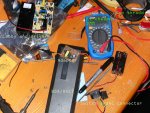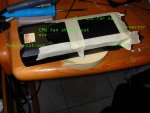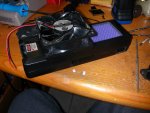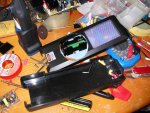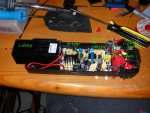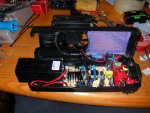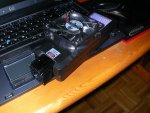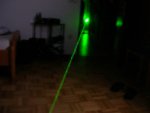brtaman
0
- Joined
- Jun 12, 2008
- Messages
- 1,199
- Points
- 48
Hello,
I don't know if anyone will be/or is interested in making themselves a porta-labby, but I decided to do a tutorial for it anyway.
DISCLAIMER: Working with AC voltage can be hazardous to ones health, I take no responsibility if you house is filled by the smell of burning bacon.
Parts required:
1x Labby with driver (I used the aixiz "50" mw labby)
1x Fan shroud from a computer (was needed in my case due to the smaller size of used box)
1x Plastic or any other box (really depends on what you have lying around and want to use, I used the box a cheap mag-lite mini rip-off)
1x Computer fan (again whatever you have lying around or want to use, mine was a 90x90mm fan taken from PSU)
1x AC socket connector (salvaged from said PSU)
1x Switch (pretty much optional but I think it adds a cool touch, again salvaged mine from an old PSU)
1x Wires (yeah wires)
1x Old adapter to be gutted (PC fans nominally run at 12v, I have been running them at 5v for a while though, airflow is good and noise is decreased, so basically any adapter over the 5v output mark will do great for this mod, the one I am using is a 5v nokia adapter)
1x Some wire or plastic "net" (this was used to increase the airflow that the vent was sucking out of the module)
Tools required:
1x soldering iron
1x heatshrink (not absolutely necessary, but recomended)
1x dremel (hack saw and a file would also work, but it would require a lot more effort)
1x files (I have a set of assorted shapes, really helped smooth out the rough edges)
1x glue or hot glue-gun (whatever is lying around)
Building:
Ok now that we have all the parts and tools needed we can begin working on the project, it took me a good couple of hours to complete but I wasn't really in a hurry.
I don't know if anyone will be/or is interested in making themselves a porta-labby, but I decided to do a tutorial for it anyway.
DISCLAIMER: Working with AC voltage can be hazardous to ones health, I take no responsibility if you house is filled by the smell of burning bacon.
Parts required:
1x Labby with driver (I used the aixiz "50" mw labby)
1x Fan shroud from a computer (was needed in my case due to the smaller size of used box)
1x Plastic or any other box (really depends on what you have lying around and want to use, I used the box a cheap mag-lite mini rip-off)
1x Computer fan (again whatever you have lying around or want to use, mine was a 90x90mm fan taken from PSU)
1x AC socket connector (salvaged from said PSU)
1x Switch (pretty much optional but I think it adds a cool touch, again salvaged mine from an old PSU)
1x Wires (yeah wires)
1x Old adapter to be gutted (PC fans nominally run at 12v, I have been running them at 5v for a while though, airflow is good and noise is decreased, so basically any adapter over the 5v output mark will do great for this mod, the one I am using is a 5v nokia adapter)
1x Some wire or plastic "net" (this was used to increase the airflow that the vent was sucking out of the module)
Tools required:
1x soldering iron
1x heatshrink (not absolutely necessary, but recomended)
1x dremel (hack saw and a file would also work, but it would require a lot more effort)
1x files (I have a set of assorted shapes, really helped smooth out the rough edges)
1x glue or hot glue-gun (whatever is lying around)
Building:
Ok now that we have all the parts and tools needed we can begin working on the project, it took me a good couple of hours to complete but I wasn't really in a hurry.


